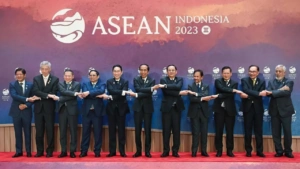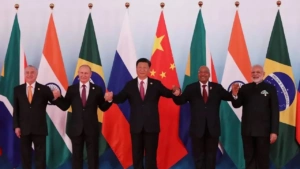
In a rapidly evolving world, the dynamics of international finance are undergoing a profound transformation. The emergence of the BRICS nations – Brazil, Russia, India, China, and South Africa – has sparked discussions about a potential shift away from the dominance of the US dollar in global transactions. This article delves into the intriguing concept of the BRICS currency and its implications for the de-dollarization movement.
What is BRICS Currency?
The term “BRICS Currency” refers to a proposed monetary unit that would serve as a common medium of exchange among the BRICS nations. BRICS is an acronym for Brazil, Russia, India, China, and South Africa, representing a coalition of major emerging economies. The concept of a BRICS currency revolves around the idea of reducing dependency on established reserve currencies, such as the US dollar and enhancing financial cooperation among these nations.
The BRICS countries, renowned for their robust economies and substantial reserves, have been inching closer toward enhancing their collective influence on the global stage. These nations have recognized the vulnerabilities associated with the overreliance on the US dollar as the world’s primary reserve currency. As a result, they have set their sights on establishing a new monetary system that could potentially reduce their dependence on the dollar.
De-Dollarization: What Does It Entail?
De-dollarization entails a deliberate effort by nations to diminish their reliance on the US dollar in international trade and finance. This ambitious endeavor involves diversifying reserves, exploring alternative payment mechanisms, and promoting the use of regional currencies for bilateral transactions. The goal is to reduce exposure to potential economic vulnerabilities arising from fluctuations in the dollar’s value and changes in US monetary policy.
BRICS Currency: A Vision Taking Shape
The idea of a unified BRICS currency has gained traction in recent years. This proposed currency could serve as a common medium of exchange within the BRICS bloc, facilitating smoother cross-border transactions and trade. While the feasibility and mechanics of such a currency are subjects of intense debate, its potential benefits cannot be ignored.
Challenges on the Path Forward
While the concept of a BRICS currency holds promise, it is not without its challenges. One of the primary hurdles is achieving consensus among the BRICS nations on the design, value, and governance of the currency. Additionally, the global financial community may view this endeavor with skepticism, potentially affecting its widespread adoption.
Impact on Global Financial Landscape
The introduction of a BRICS currency could have far-reaching implications for the global financial landscape. It could encourage other nations to reevaluate their currency reserves and diversify their holdings, thereby contributing to a more balanced and multipolar monetary system. This shift could potentially reduce the dominance of the US dollar, leading to a more equitable distribution of financial power.
The Road Ahead: Navigating Uncertainties
As the BRICS nations continue to deliberate and strategize on the feasibility of a unified currency, uncertainties persist. The intricate web of economic, geopolitical, and technological factors adds complexity to the journey toward de-dollarization. However, the mere contemplation of such a transformative shift speaks volumes about the evolving dynamics of the international financial arena.
Conclusion: A Paradigm Shift in Progress
In conclusion, the concept of a BRICS currency marks a significant paradigm shift in the world of finance. While the path ahead is beset with challenges and uncertainties, the very exploration of such an idea reflects the determination of the BRICS nations to reshape the global economic landscape. As the dialogue on de-dollarization gains momentum, it will be fascinating to witness the evolution of this vision and its potential impact on a dynamic and interconnected world.








